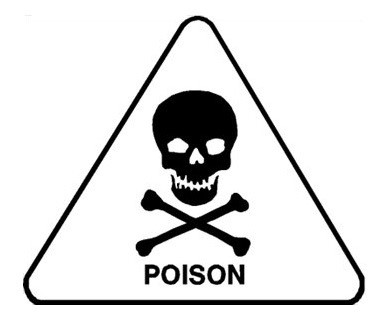
Credit: Public domain
For more than 20,000 years, humans have used poison—in hunting, in pest and plant control, and even to kill other humans.
Castor bean residue is the source for ricin, which causes multiple organ failure. But it’s used by some indigenous tribes on their hunting arrows.
But the deadliest synthetic poison is VX, a nerve agent that stops victims' breathing. Originally developed as an insecticide, it proved too lethal for that. One gram could kill 2,500 people.
Another profoundly lethal poison is the radioactive isotope of polonium, famously used to assassinate a Russian dissident in 2006. One gram could kill 10 million people.
The most deadly one, surprisingly, is used routinely. Extremely tiny quantities of botulinum toxin, produced by bacteria, are used to paralyze facial muscles to reduce wrinkles. But just one gram could kill one billion people!
All these may be deadly, but the riskiest poisons are the ones found at home—cabinets full of pesticides, cleaning solutions and medications.
There’s one poisoning reported in the U.S. every eight seconds, and 90 percent of them occur in households.
Little kids tend to put things in their mouths, so they’re the most vulnerable. Nearly 4 percent of children below six will have a poison exposure.
A good reason to put child locks on cabinets that contain potentially poisonous household chemicals.
Background
Synopsis: Humans have used poison for thousands of years for hunting and killing. A variety of poisons, from organic toxins and venoms to inorganic chemicals, come from the natural world. But most of today’s common household products are synthetic toxicants made in laboratories. In 1961, the third week of March was designated as National Poison Prevention Week to raise awareness of accidental household poisonings, most of which occur in children under the age of six. Certain substances are said to be more poisonous because tiny doses cause human distress and death, but it is important to note that anything, even water, can be poisonous in excess.
- Toxicology is the study of harmful effects of chemicals on living organisms. Any chemical substance that causes a biological disturbance in an organism is a poison.
- Poisons may be swallowed, inhaled, injected, or absorbed through the skin.
- Different animals may have different sensitivities to toxic substances.
- Poisons can be divided into biologically produced toxins and lab produced (synthetic) toxicants.
- Toxins may be secreted by poisonous organisms (you bite it) or intentionally injected by venomous animals (it bites you) through stingers or fangs.
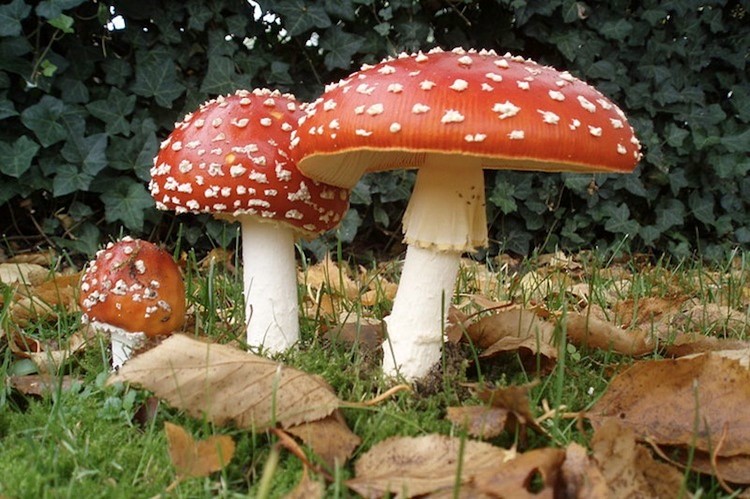
Amanita muscaria mushrooms, otherwise known as “magic mushrooms,” are iconic poisonous mushrooms reminiscent of Mario games. Low dosages are psychoactive.
Credit: Onderwijsgek, via Wikimedia Commons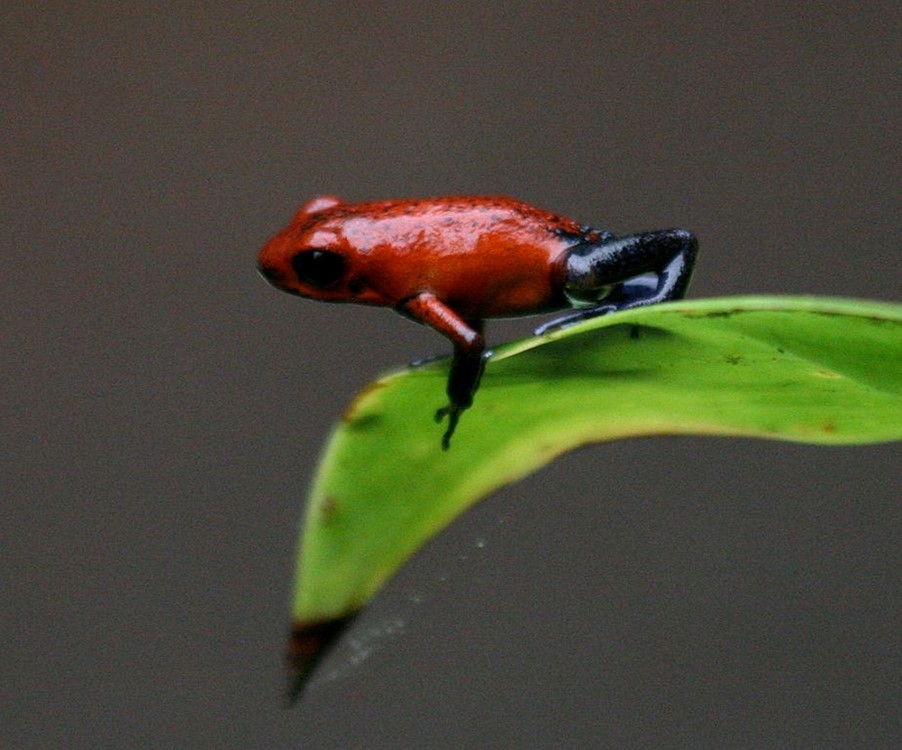
A strawberry poison dart frog from Costa Rica. Used in traditional indigenous dart hunting, each tiny frog carries enough poison to kill several humans if introduced into the bloodstream or ingested. Their poison may originate from the beetles they eat.
Credit: EcohawkeyeCreator:David Dodge, via Wikimedia Commons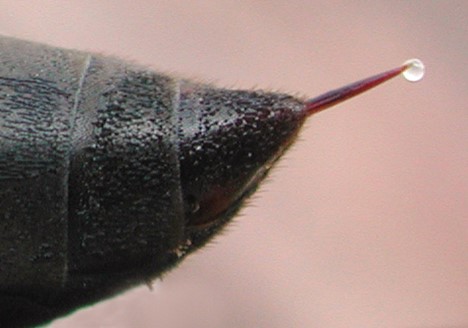
Wasp stinger closeup with a venom droplet. Venom may be injected from stingers and fangs for defense or to immobilize prey.
Credit: Pollinator, via Wikipedia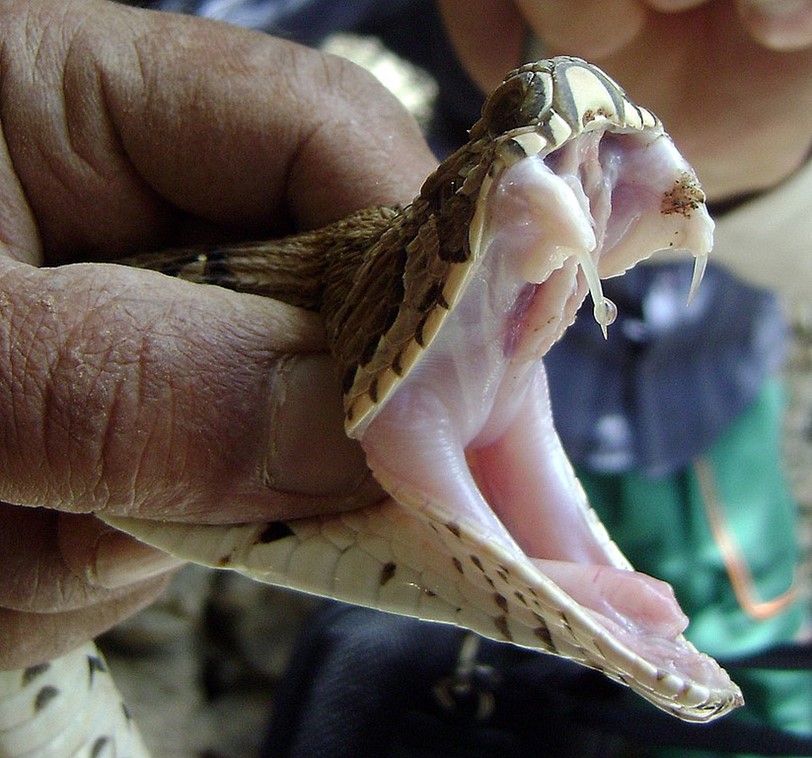
A Russell's viper’s fangs with venom expression. This snake is native to the Indian subcontinent and is responsible for the most snakebite incidents and deaths among all venomous snakes.
Credit: Usman Ahmad from Pakistan, via Wikimedia Commons - Different poisons may impact different bodily functions. Some destroy red blood cells, some affect the central nervous system, liver or other organs, some cause allergic reactions, and others destroy cells and tissue or immobilize muscles.
- Many synthetic toxicants are poisons that have been formulated for use in common household products.
- Poisons have been used intentionally by humans for millennia. The oldest known toxins were found in the Border Cave in the Lebombo Mountains, KwaZulu-Natal, South Africa.
- We described recent Border Cave discoveries in ED-277 Making a 200,000-Year-Old Bed.
- While the Border Cave contains much older artifacts, a notched wooden stick with trace amounts of a castor bean residue called ricinoleic acid in its grooves was dated to 24,000 years ago in the Upper Paleolithic Period.
- Similar to usage by today’s San people, the applicator is thought to have been used to apply poison to bone-tipped arrows for more effective hunting.
- Castor bean residue is the source of ricin, one of the deadliest poisons known today that was used to kill the Bulgarian dissident Georgi Markov in 1978.
- Poisons are still used by indigenous peoples for hunting in Africa, South America and Asia.
- From the time of the Roman Empire to today, poison has been actively and intentionally used in warfare, including assassinations, suicides and executions. The deadliest six poisons come from a variety of sources and include:
- A radioactive isotope of polonium, 210Po, is the deadliest poison known; one gram could kill 10 million people. It was used to kill Alexander Litvinenko in 2006 and may have been used to kill Yasser Arafat in 2004.
- Anaerobic bacteria produce botulinum toxin; just one nanogram can kill a person by causing paralysis. Extremely small quantities are used in the cosmetic treatment Botox to smooth skin by shutting down certain facial muscles.
- A microscopic marine dinoflagellate called Gambierdiscus toxicus produces maitotoxin, which sometimes causes shellfish poisoning leading to heart failure.
- Secretions from the skins of tiny rainforest frogs include batrachotoxin that is used to arm poison darts used in indigenous hunting. Two table salt sized grains will stop a human heart. Frogs raised in captivity don’t produce the toxin, so scientists believe they get the toxin from beetles they eat in the forest.
- The only synthetic toxicant in the top six list is VX, which is a nerve agent that causes asphyxiation. Originally concocted as an insecticide, this engine oil thick liquid was too toxic for that. Just 0.4 mg will kill a healthy adult—this was the poison used to kill Kim Jong Nam in 2017.
- Ingesting a few milligrams of toxin derived from the beans of the castor oil plant called ricin stops protein production in the body, causing multiple organ failures. It is even deadlier if injected or inhaled.
- These poisons may be deadly, but the riskiest poisons are the more accessible ones found in most households—cabinets full of pesticides, cleaning solutions, disinfectants, medications, vitamins and preservatives.
- Most of these poisons are toxicants developed in chemical laboratories. Easy access to these substances increases opportunity for unintentional poisonings.
- In 2020, more than 2.1 million human poison exposures were called in to the 55 poison control centers in the United States.
- That is one poison exposure called in every eight seconds, adding up to about 6.4 poisonings per 1,000 Americans.
- Ninety percent of poisonings occurred inside homes.
- Little kids tend to put everything they find into their mouth, so they are the most vulnerable. There were 37.9 poison exposures per 1,000 children below six.
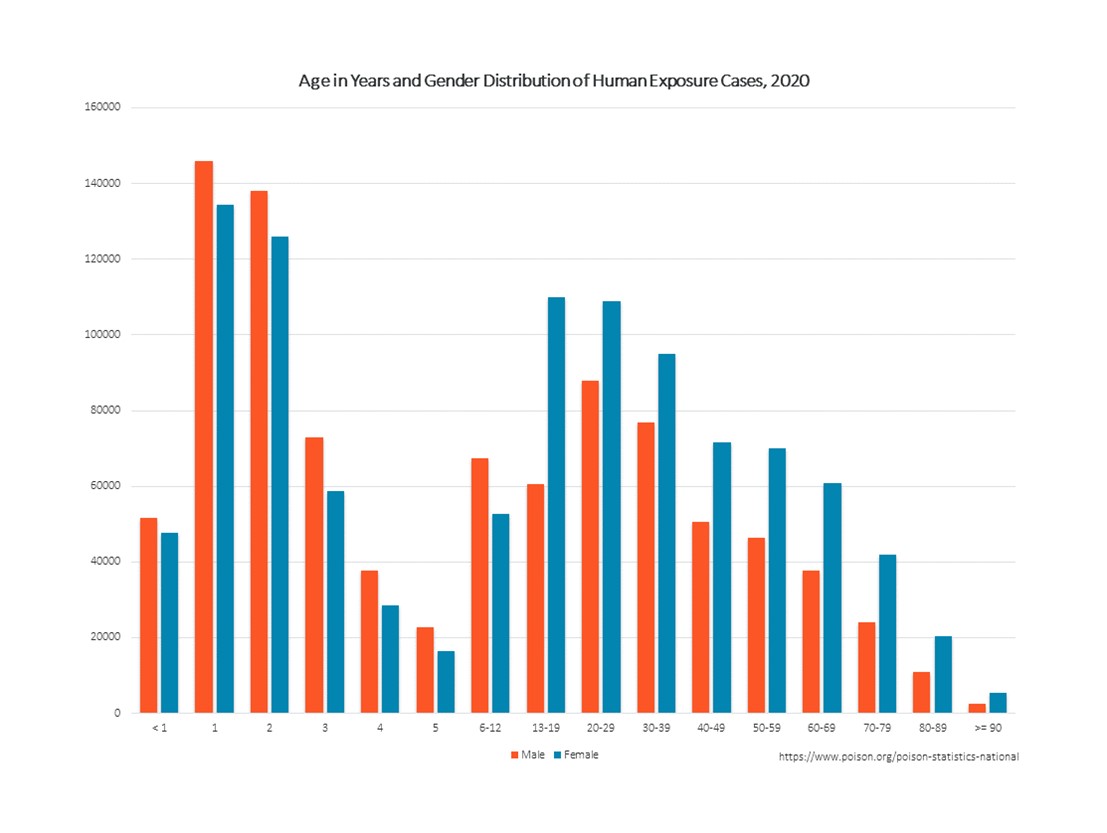
Children are more likely to ingest poisons than adults, and little boys tend to get into poison more often than little girls. Adult females are more likely to be exposed to poison than males.
Credit: Poison.org - To increase awareness of the dangers of unintentional household poisonings, in 1961, the U.S. Congress requested President Kennedy issue a proclamation designating the third week of March as National Poison Prevention Week.
- “The dose makes the poison” is a Latin adage ("Sola dosis facit venenum") that illustrates a key concept about poisons.
- Everything can be toxic if too much is ingested, even water.
- In the early 1500’s a Swiss physician named Paracelsus stated, "All things are poison, and nothing is without poison; the dosage alone makes it so a thing is not a poison."
- Water intoxication and deaths have occurred.
- Poison antidotes are created from the toxins themselves by injecting small doses into an animal that produces antibodies that are harvested from the animals bloodstream to make antitoxin serums that are used to save human lives in emergency situations.
- Some poisons do not have antidotes.

